The Bristol Maker Walk – what’s it all about?
Posted on by Lauren MacCarthy.
by Lee Hutchinson, Curator of Industrial and Maritime History
Over recent weeks, our Industrial and Maritime History department, based at M Shed, has been taking part in the Bristol Maker Walk project. But why – and what’s it all about?
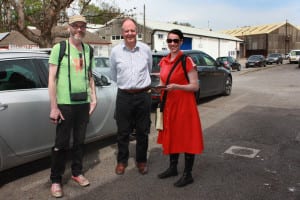
Maker Walk team (l-r): Frank O’Connor (Artstation), Chris McMahon (University of Bristol) and Jude Sherry (University of Bath)
Put simply, it’s a physical exploration of urban manufacturing in Bristol – to find out who is making what, where and how. Frustrated by the aggregate and dated nature of official statistics and inspired by the Open Source Mapping movement, the project has been undertaken by Redistributed Manufacturing in a Resilient, Sustainable City (RDM | RSC) – a network project funded by the Engineering and Physical Sciences Research Council (EPSRC).
As Jude Sherry of the University of Bath, researcher and Maker Walk lead, explains:
“Walking, meeting and recording local makers and manufacturers will provide a unique picture of urban manufacturing that moves beyond aggregated statistics and incomplete company directories. The results of this walk will be communicated through an interactive and open geographic information system (GIS), as well as blog posts, videos, photographs and a public report shared online.”
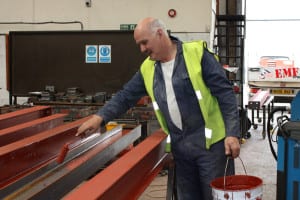 This is a novel approach to mapping manufacturers – one that the project team hopes will ultimately be replicated across the regions. But it’s no light undertaking to physically visit each and every manufacturer across the city. For this reason the Maker Walk will start small by initially exploring Bristol’s BS3 postal code area and grow over time.
This is a novel approach to mapping manufacturers – one that the project team hopes will ultimately be replicated across the regions. But it’s no light undertaking to physically visit each and every manufacturer across the city. For this reason the Maker Walk will start small by initially exploring Bristol’s BS3 postal code area and grow over time.
As Jude says: “It’s a feasibility study, which along with testing initial methodologies and gathering key insights and data will assess the practicality of undertaking a comprehensive manufacturing study on a city or regional scale.”
So why has the museum service and in particular M Shed chosen to take part? For a variety of reasons, but not least because as a popular public-service institution, M Shed can support the resurgence of interest in local making and contribute to the goal of establishing Bristol as a resilient and sustainable city. Manufacturing skills play a crucial role in achieving this aim, as without them, the city would struggle to manage its physical resources or transition to a low-waste and resource-efficient circular economy.
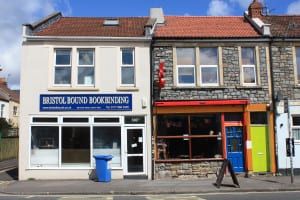 From a museological perspective, the findings of the Maker Walk will be of value to the city’s industrial-history archive. As Jude has illustrated, at any point in time it is virtually impossible to know with certainty what is being made where and by whom. Directories are rarely complete, and SIC codes (Standard Industrial Classification) of economic activities can’t be relied upon since these are often out of date and an inaccurate indication of manufacturing activities.
From a museological perspective, the findings of the Maker Walk will be of value to the city’s industrial-history archive. As Jude has illustrated, at any point in time it is virtually impossible to know with certainty what is being made where and by whom. Directories are rarely complete, and SIC codes (Standard Industrial Classification) of economic activities can’t be relied upon since these are often out of date and an inaccurate indication of manufacturing activities.
Through building an accurate picture of what is being made in the city, this information can be used not only to create a meticulous and detailed map of local manufacturing activity (of use to traders, environmentalists, historians etc) but also to inform and enhance M Shed’s contemporary-collecting process. It is a common misconception that museums only ‘preserve old treasures’, when, in reality, it’s essential for living museums like M Shed to collect the under-represented and the new. While resource-intensive, collecting contemporary cultural heritage can improve inclusivity and diversify the demographics of the collection.
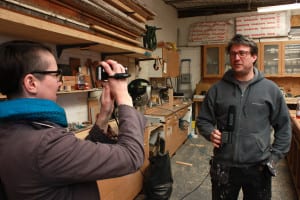 And it’s not just 3D objects that are of interest. From a social-historical perspective, the stories, sights and sounds of the manufacturing workshops are of equal value; and through the insights gained via the Maker Walk, these can be captured through photography, audio and video.
And it’s not just 3D objects that are of interest. From a social-historical perspective, the stories, sights and sounds of the manufacturing workshops are of equal value; and through the insights gained via the Maker Walk, these can be captured through photography, audio and video.
The Maker Walk has been taking place throughout April and will continue into May. Already it has presented some intriguing challenges – not least the question of what defines ‘making’. As Professor Mike Lewis of the University of Bath observed:
“Most manufacturing doesn’t involve what most people would imagine – the act of genesis that’s implied in the word ‘make’ – rather it is an eclectic mix of value-adding activities.”
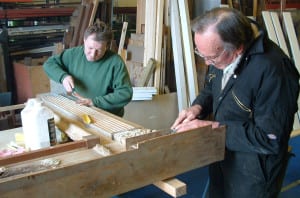 As a result, the team has adopted a broad definition that includes ‘any process that involves any physical or chemical transformation of materials into new products’. Accordingly, this definition therefore includes cafes, restaurants, food-serving pubs, food vans, supermarket bakeries etc.
As a result, the team has adopted a broad definition that includes ‘any process that involves any physical or chemical transformation of materials into new products’. Accordingly, this definition therefore includes cafes, restaurants, food-serving pubs, food vans, supermarket bakeries etc.
The findings that have been reported to date are providing an interesting snapshot of the economic health of South Bristol – with a gamut of small-scale and cottage-type industries coming to the fore, from window makers, stained-glass makers and T-shirt makers, to furniture makers, bookbinders and microbrewers.
It would appear, from preliminary findings at least, that Bristol really is a city of enterprising makers and doers.
You can listen to an interview with Maker Walk lead Jude Sherry on Soundcloud.
One comment on The Bristol Maker Walk – what’s it all about?
Great post Lee. This really shows the importance connecting with local industry. I couldn’t agree with you more on the importance of showing these wonderful hidden spaces to others. Especially through video and sound could tell a unique story of what Bristol makes.